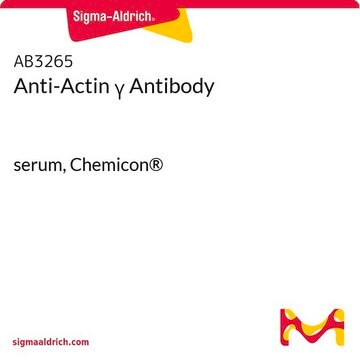A1978
Anti-β-Actin antibody, Mouse monoclonal
clone AC-15, purified from hybridoma cell culture
Synonym(s):
Monoclonal Anti-β-Actin
About This Item
Recommended Products
biological source
mouse
conjugate
unconjugated
antibody form
purified immunoglobulin
antibody product type
primary antibodies
clone
AC-15, monoclonal
form
buffered aqueous solution
mol wt
antigen 42 kDa
species reactivity
sheep, carp, feline, chicken, rat, mouse, Hirudo medicinalis, rabbit, canine, pig, human, bovine, guinea pig
should not react with
Dictyostelium discoideum
technique(s)
immunocytochemistry: 10-40 μg/mL using human foreskin fibroblasts
immunohistochemistry (frozen sections): suitable
indirect immunofluorescence: suitable
microarray: suitable
western blot: 0.5-1 μg/mL using cell extract of human foreskin fibroblasts or chicken fibroblasts.
isotype
IgG1
UniProt accession no.
application(s)
research pathology
shipped in
dry ice
storage temp.
−20°C
target post-translational modification
unmodified
Gene Information
human ... ACTB(60)
mouse ... Actb(11461)
rat ... Actb(81822)
Looking for similar products? Visit Product Comparison Guide
General description
In staining of chicken gizzard ultrathin tissue cryosections, the antibody labels the dense bodies and longitudinal channels linking consecutive dense bodies that are also occupied by desmin and the membrane-associated dense plaque. It does not stain adult cardiac and skeletal muscles except for traces due to contaminations of the sample with non-muscle cells, or if embryonic tissue is being used.
Specificity
Immunogen
Application
The antibody can be used for staining of acetone-fixed frozen sections, EM preparations, and microinjection experiments. B5, ethanol, methacam, or Bouin′s solutions can be used as fixatives. The epitope recognized by the antibody is resistant to formalin-fixation and paraffin-embedding.
Monoclonal anti-beta-actin antibody can be used for microarray, indirect immunofluorescence, and immunohistochemical analyses. Furthermore, the product has been used for immunocytochemistry at 10-40 μg/mL using human foreskin fibroblasts. The antibody has also been used for western blot at 0.5-1 μg/mL using cell extract of human foreskin fibroblasts or chicken fibroblasts.
The antibody can be used for staining of acetone-fixed frozen sections, EM preparations, and microinjection experiments. B5, ethanol, methacam, or Bouin′s solutions can be used as fixatives. The epitope recognized by the antibody is resistant to formalin-fixation and paraffin-embedding.
It has been used in Immunoblot analysis.
Biochem/physiol Actions
ACTB (β-actin) is crucial for organogenesis, especially for the development of brain, kidney and heart. It is responsible for maintaining cell proliferation, migration and shape. Actin protein is essential for the formation of mature platelets. β−Actin plays a key role in embryonic development. Upregulation of β-actin stimulates membrane protrusions and helps in cellular motility. The encoded protein β-Actin mediates fibroblast migration in mouse and thereby control connective tissue tension.
Actin is a cytoskeletal protein that regulates cell motility, secretion, phagocytosis and cytokinesis. The NH2-terminal of actin may function as an antigen. This terminal may also modulate actin interactions and may associate with proteins such as myosin.
Physical form
Preparation Note
Other Notes
Disclaimer
Not finding the right product?
Try our Product Selector Tool.
recommended
Storage Class Code
10 - Combustible liquids
WGK
WGK 3
Flash Point(F)
Not applicable
Flash Point(C)
Not applicable
Certificates of Analysis (COA)
Search for Certificates of Analysis (COA) by entering the products Lot/Batch Number. Lot and Batch Numbers can be found on a product’s label following the words ‘Lot’ or ‘Batch’.
Already Own This Product?
Find documentation for the products that you have recently purchased in the Document Library.
Customers Also Viewed
Our team of scientists has experience in all areas of research including Life Science, Material Science, Chemical Synthesis, Chromatography, Analytical and many others.
Contact Technical Service












